Stewardship and Governance: Theories, Contributions, and Applications
VerifiedAdded on 2022/11/25
|13
|3137
|181
Report
AI Summary
This report delves into the critical aspects of stewardship and governance, offering a comprehensive analysis of its significance within various organizational structures. It begins by introducing the concept of corporate governance and its importance, particularly in environments with multiple stakeholders. The report then explores key corporate governance theories, including agency theory, stakeholder theory, resource dependency theory, and, most importantly, stewardship theory. It examines the contributions of stewardship theory to effective governance, focusing on its application in both non-profit and profit organizations. The report highlights how stewardship theory promotes accountability, shared decision-making, and the prioritization of organizational goals over self-interest, making it a valuable framework for leaders and managers. Furthermore, it discusses the roles of committees, trustees, and board members in ensuring that organizations fulfill their objectives, especially in the context of non-profit entities. Finally, it explores the governance structure of profit-oriented organizations, emphasizing how the principles of stewardship theory can be applied to enhance corporate performance and accountability. The report provides a well-rounded understanding of stewardship and governance, offering valuable insights for students of leadership and management.
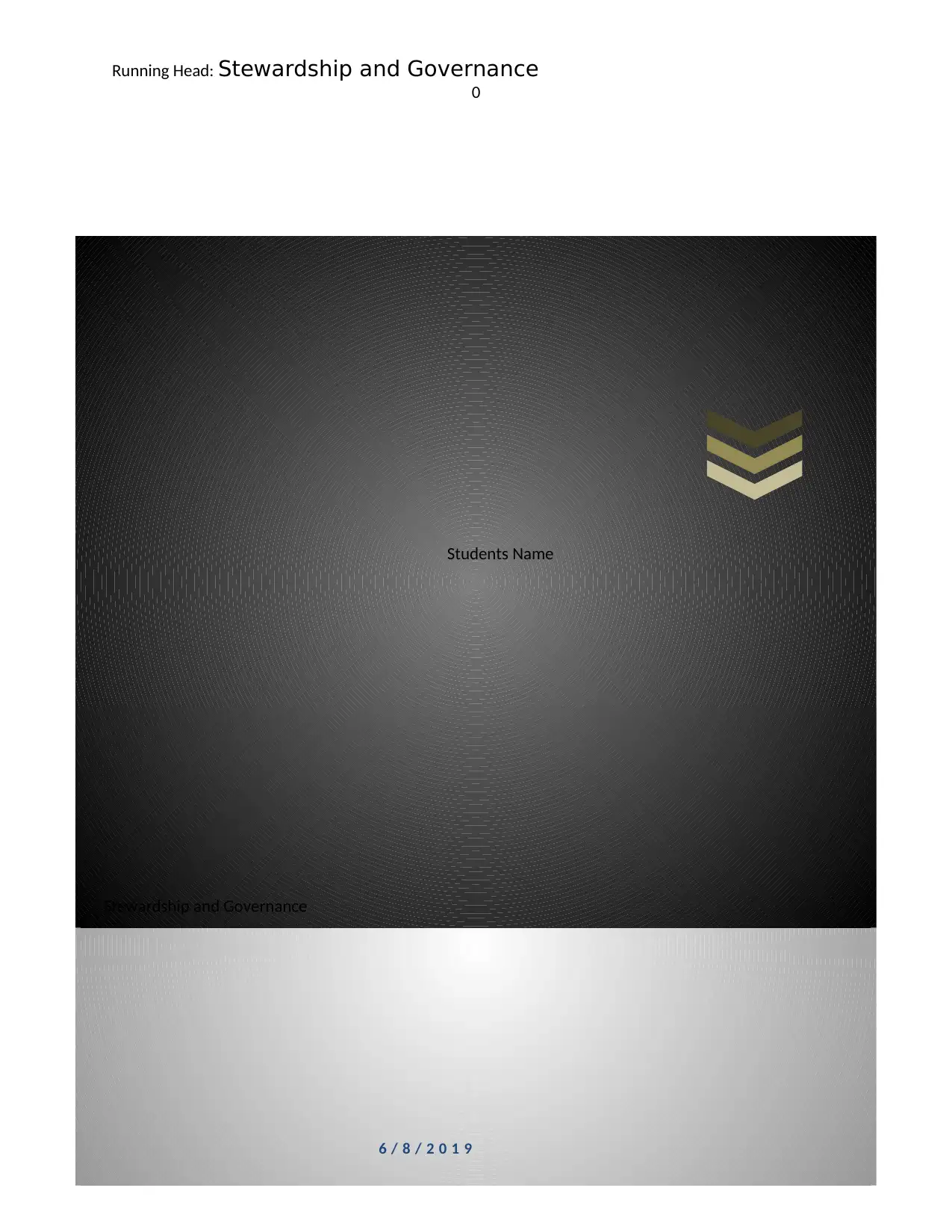
Stewardship and Governance
Running Head: Stewardship and Governance
0
6 / 8 / 2 0 1 9
Students Name
Running Head: Stewardship and Governance
0
6 / 8 / 2 0 1 9
Students Name
Paraphrase This Document
Need a fresh take? Get an instant paraphrase of this document with our AI Paraphraser
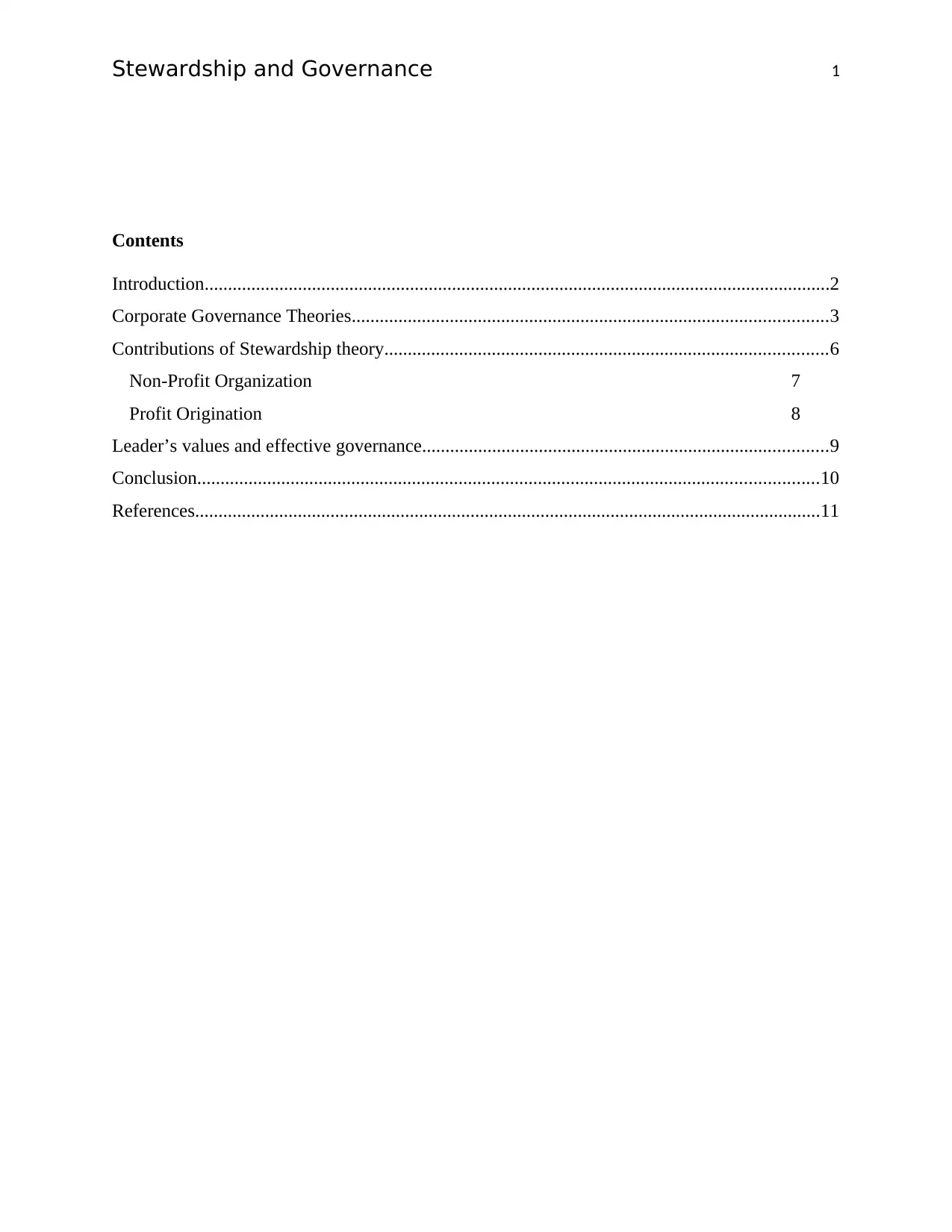
Stewardship and Governance 1
Contents
Introduction......................................................................................................................................2
Corporate Governance Theories......................................................................................................3
Contributions of Stewardship theory...............................................................................................6
Non-Profit Organization 7
Profit Origination 8
Leader’s values and effective governance.......................................................................................9
Conclusion.....................................................................................................................................10
References......................................................................................................................................11
Contents
Introduction......................................................................................................................................2
Corporate Governance Theories......................................................................................................3
Contributions of Stewardship theory...............................................................................................6
Non-Profit Organization 7
Profit Origination 8
Leader’s values and effective governance.......................................................................................9
Conclusion.....................................................................................................................................10
References......................................................................................................................................11
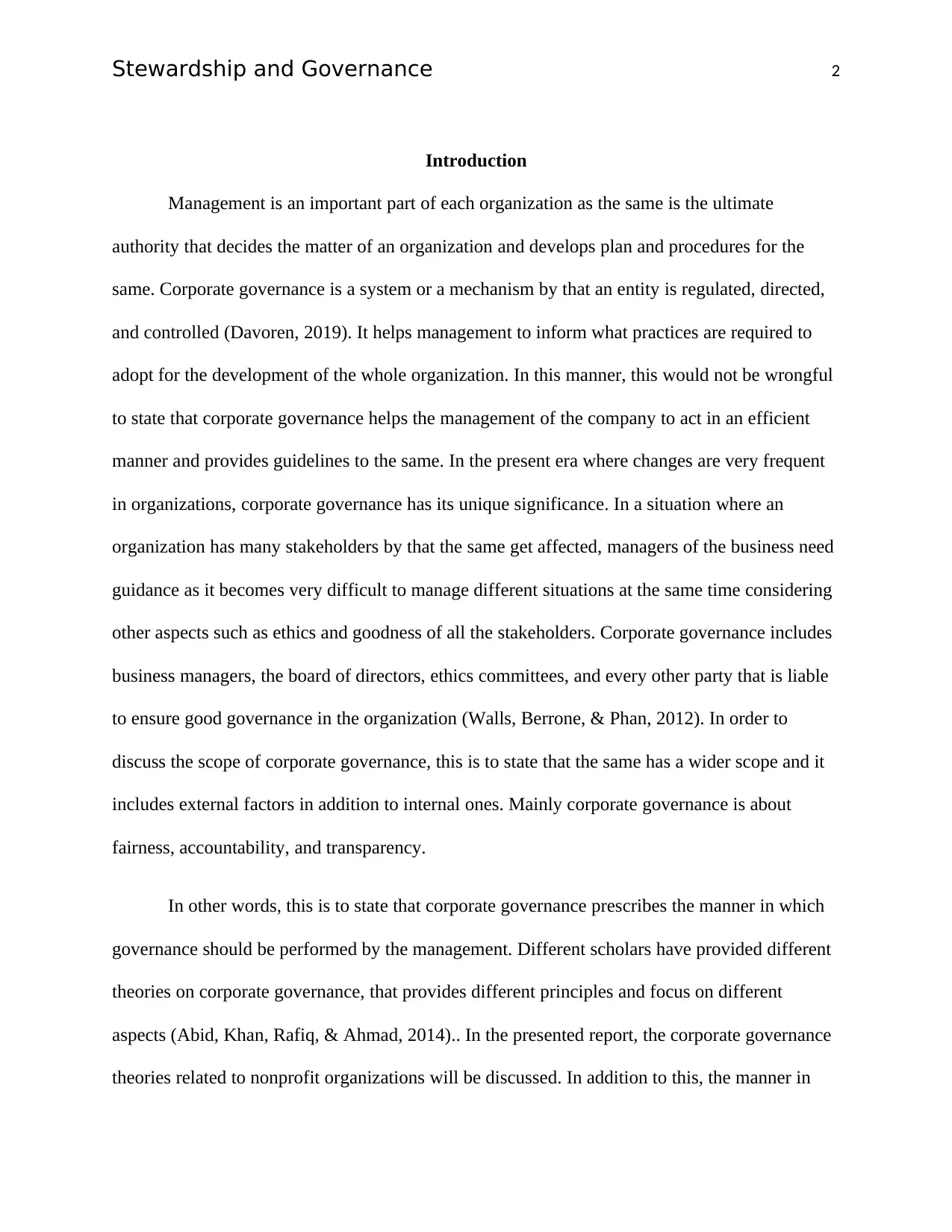
Stewardship and Governance 2
Introduction
Management is an important part of each organization as the same is the ultimate
authority that decides the matter of an organization and develops plan and procedures for the
same. Corporate governance is a system or a mechanism by that an entity is regulated, directed,
and controlled (Davoren, 2019). It helps management to inform what practices are required to
adopt for the development of the whole organization. In this manner, this would not be wrongful
to state that corporate governance helps the management of the company to act in an efficient
manner and provides guidelines to the same. In the present era where changes are very frequent
in organizations, corporate governance has its unique significance. In a situation where an
organization has many stakeholders by that the same get affected, managers of the business need
guidance as it becomes very difficult to manage different situations at the same time considering
other aspects such as ethics and goodness of all the stakeholders. Corporate governance includes
business managers, the board of directors, ethics committees, and every other party that is liable
to ensure good governance in the organization (Walls, Berrone, & Phan, 2012). In order to
discuss the scope of corporate governance, this is to state that the same has a wider scope and it
includes external factors in addition to internal ones. Mainly corporate governance is about
fairness, accountability, and transparency.
In other words, this is to state that corporate governance prescribes the manner in which
governance should be performed by the management. Different scholars have provided different
theories on corporate governance, that provides different principles and focus on different
aspects (Abid, Khan, Rafiq, & Ahmad, 2014).. In the presented report, the corporate governance
theories related to nonprofit organizations will be discussed. In addition to this, the manner in
Introduction
Management is an important part of each organization as the same is the ultimate
authority that decides the matter of an organization and develops plan and procedures for the
same. Corporate governance is a system or a mechanism by that an entity is regulated, directed,
and controlled (Davoren, 2019). It helps management to inform what practices are required to
adopt for the development of the whole organization. In this manner, this would not be wrongful
to state that corporate governance helps the management of the company to act in an efficient
manner and provides guidelines to the same. In the present era where changes are very frequent
in organizations, corporate governance has its unique significance. In a situation where an
organization has many stakeholders by that the same get affected, managers of the business need
guidance as it becomes very difficult to manage different situations at the same time considering
other aspects such as ethics and goodness of all the stakeholders. Corporate governance includes
business managers, the board of directors, ethics committees, and every other party that is liable
to ensure good governance in the organization (Walls, Berrone, & Phan, 2012). In order to
discuss the scope of corporate governance, this is to state that the same has a wider scope and it
includes external factors in addition to internal ones. Mainly corporate governance is about
fairness, accountability, and transparency.
In other words, this is to state that corporate governance prescribes the manner in which
governance should be performed by the management. Different scholars have provided different
theories on corporate governance, that provides different principles and focus on different
aspects (Abid, Khan, Rafiq, & Ahmad, 2014).. In the presented report, the corporate governance
theories related to nonprofit organizations will be discussed. In addition to this, the manner in
⊘ This is a preview!⊘
Do you want full access?
Subscribe today to unlock all pages.

Trusted by 1+ million students worldwide
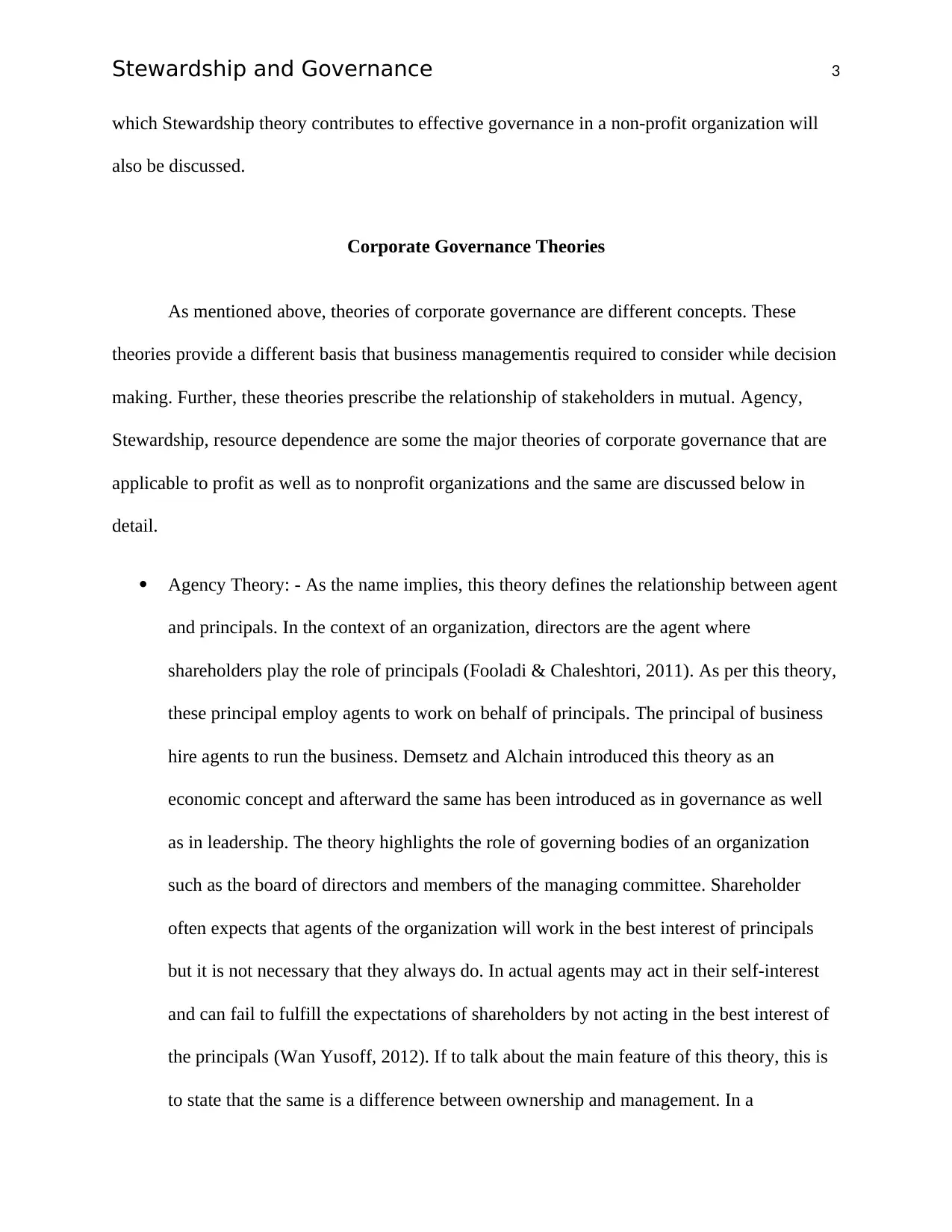
Stewardship and Governance 3
which Stewardship theory contributes to effective governance in a non-profit organization will
also be discussed.
Corporate Governance Theories
As mentioned above, theories of corporate governance are different concepts. These
theories provide a different basis that business managementis required to consider while decision
making. Further, these theories prescribe the relationship of stakeholders in mutual. Agency,
Stewardship, resource dependence are some the major theories of corporate governance that are
applicable to profit as well as to nonprofit organizations and the same are discussed below in
detail.
Agency Theory: - As the name implies, this theory defines the relationship between agent
and principals. In the context of an organization, directors are the agent where
shareholders play the role of principals (Fooladi & Chaleshtori, 2011). As per this theory,
these principal employ agents to work on behalf of principals. The principal of business
hire agents to run the business. Demsetz and Alchain introduced this theory as an
economic concept and afterward the same has been introduced as in governance as well
as in leadership. The theory highlights the role of governing bodies of an organization
such as the board of directors and members of the managing committee. Shareholder
often expects that agents of the organization will work in the best interest of principals
but it is not necessary that they always do. In actual agents may act in their self-interest
and can fail to fulfill the expectations of shareholders by not acting in the best interest of
the principals (Wan Yusoff, 2012). If to talk about the main feature of this theory, this is
to state that the same is a difference between ownership and management. In a
which Stewardship theory contributes to effective governance in a non-profit organization will
also be discussed.
Corporate Governance Theories
As mentioned above, theories of corporate governance are different concepts. These
theories provide a different basis that business managementis required to consider while decision
making. Further, these theories prescribe the relationship of stakeholders in mutual. Agency,
Stewardship, resource dependence are some the major theories of corporate governance that are
applicable to profit as well as to nonprofit organizations and the same are discussed below in
detail.
Agency Theory: - As the name implies, this theory defines the relationship between agent
and principals. In the context of an organization, directors are the agent where
shareholders play the role of principals (Fooladi & Chaleshtori, 2011). As per this theory,
these principal employ agents to work on behalf of principals. The principal of business
hire agents to run the business. Demsetz and Alchain introduced this theory as an
economic concept and afterward the same has been introduced as in governance as well
as in leadership. The theory highlights the role of governing bodies of an organization
such as the board of directors and members of the managing committee. Shareholder
often expects that agents of the organization will work in the best interest of principals
but it is not necessary that they always do. In actual agents may act in their self-interest
and can fail to fulfill the expectations of shareholders by not acting in the best interest of
the principals (Wan Yusoff, 2012). If to talk about the main feature of this theory, this is
to state that the same is a difference between ownership and management. In a
Paraphrase This Document
Need a fresh take? Get an instant paraphrase of this document with our AI Paraphraser
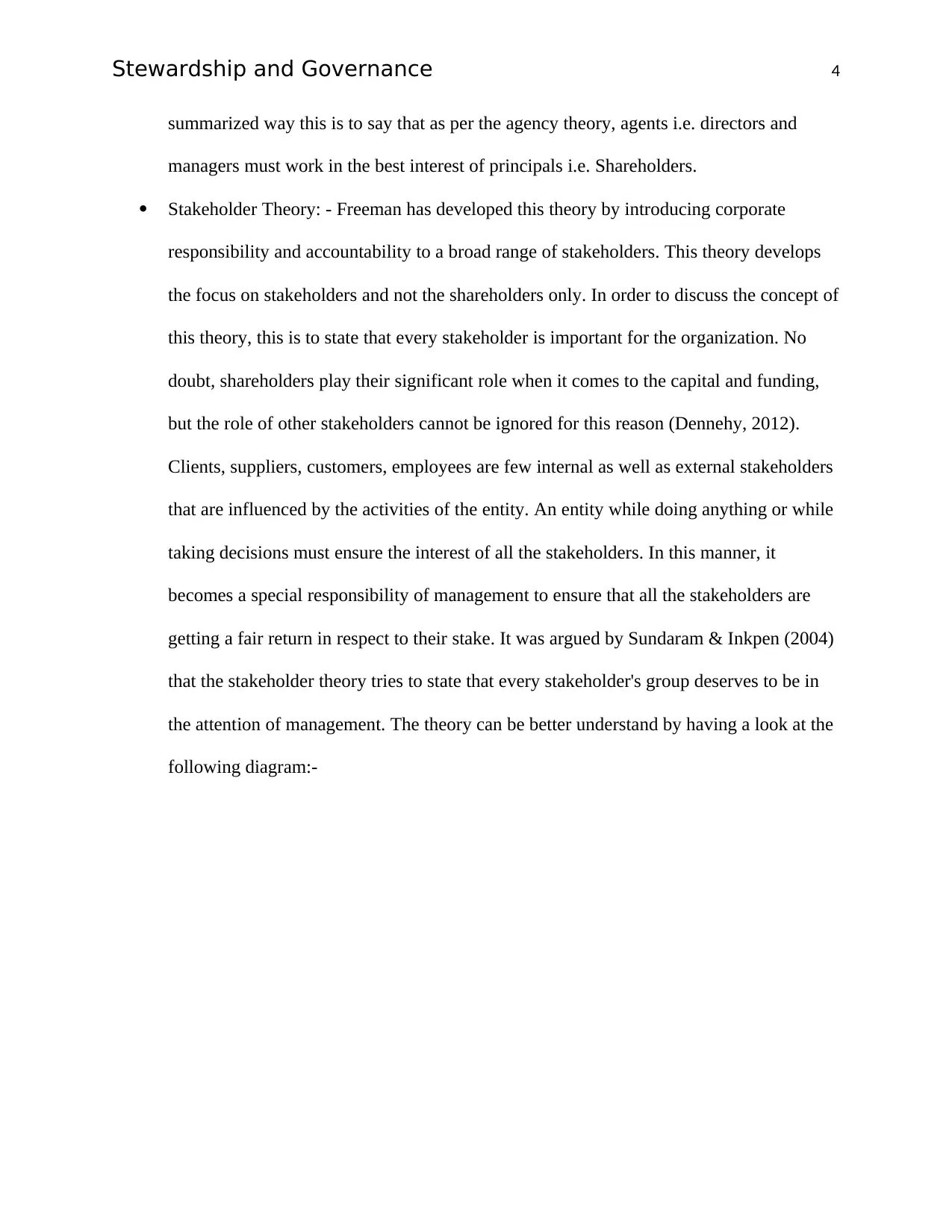
Stewardship and Governance 4
summarized way this is to say that as per the agency theory, agents i.e. directors and
managers must work in the best interest of principals i.e. Shareholders.
Stakeholder Theory: - Freeman has developed this theory by introducing corporate
responsibility and accountability to a broad range of stakeholders. This theory develops
the focus on stakeholders and not the shareholders only. In order to discuss the concept of
this theory, this is to state that every stakeholder is important for the organization. No
doubt, shareholders play their significant role when it comes to the capital and funding,
but the role of other stakeholders cannot be ignored for this reason (Dennehy, 2012).
Clients, suppliers, customers, employees are few internal as well as external stakeholders
that are influenced by the activities of the entity. An entity while doing anything or while
taking decisions must ensure the interest of all the stakeholders. In this manner, it
becomes a special responsibility of management to ensure that all the stakeholders are
getting a fair return in respect to their stake. It was argued by Sundaram & Inkpen (2004)
that the stakeholder theory tries to state that every stakeholder's group deserves to be in
the attention of management. The theory can be better understand by having a look at the
following diagram:-
summarized way this is to say that as per the agency theory, agents i.e. directors and
managers must work in the best interest of principals i.e. Shareholders.
Stakeholder Theory: - Freeman has developed this theory by introducing corporate
responsibility and accountability to a broad range of stakeholders. This theory develops
the focus on stakeholders and not the shareholders only. In order to discuss the concept of
this theory, this is to state that every stakeholder is important for the organization. No
doubt, shareholders play their significant role when it comes to the capital and funding,
but the role of other stakeholders cannot be ignored for this reason (Dennehy, 2012).
Clients, suppliers, customers, employees are few internal as well as external stakeholders
that are influenced by the activities of the entity. An entity while doing anything or while
taking decisions must ensure the interest of all the stakeholders. In this manner, it
becomes a special responsibility of management to ensure that all the stakeholders are
getting a fair return in respect to their stake. It was argued by Sundaram & Inkpen (2004)
that the stakeholder theory tries to state that every stakeholder's group deserves to be in
the attention of management. The theory can be better understand by having a look at the
following diagram:-
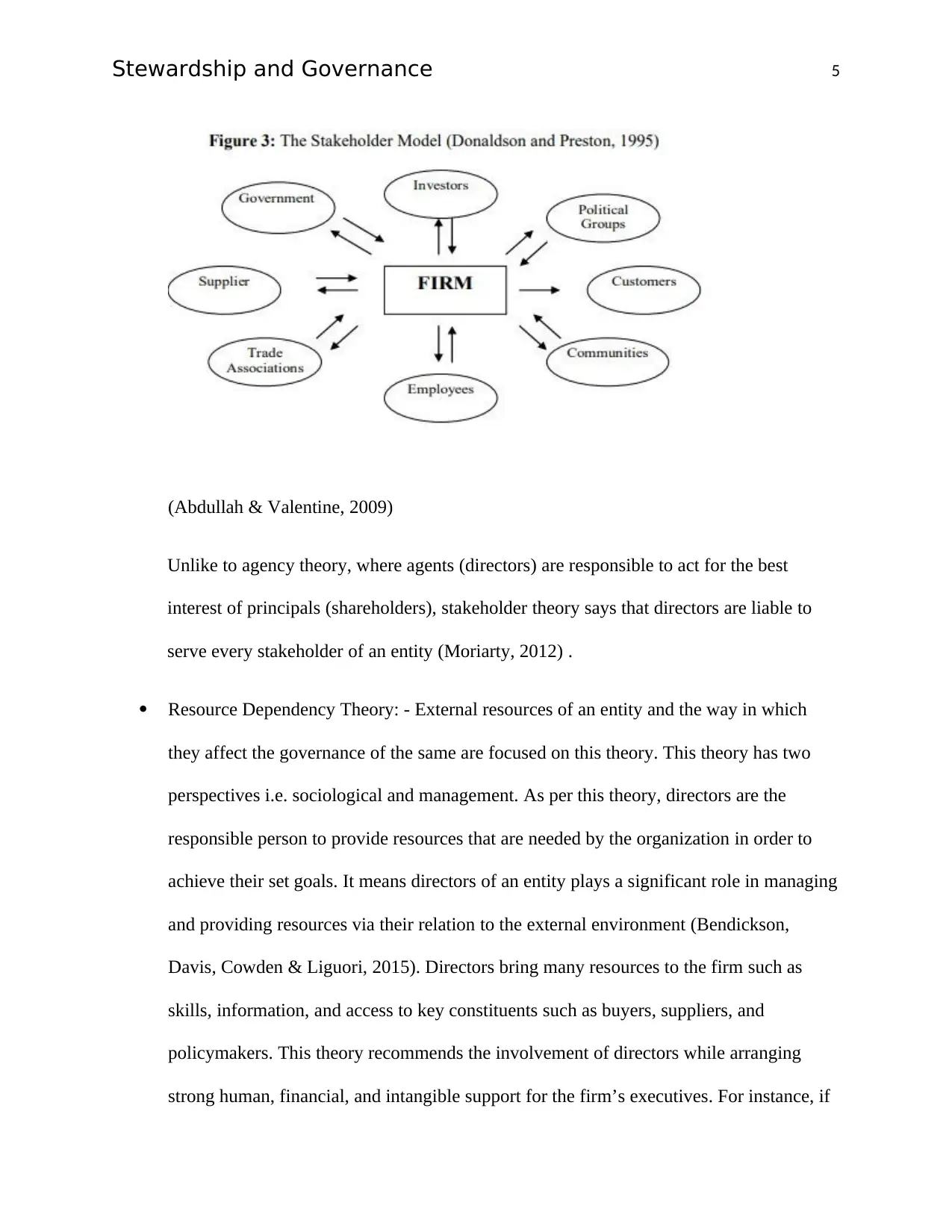
Stewardship and Governance 5
(Abdullah & Valentine, 2009)
Unlike to agency theory, where agents (directors) are responsible to act for the best
interest of principals (shareholders), stakeholder theory says that directors are liable to
serve every stakeholder of an entity (Moriarty, 2012) .
Resource Dependency Theory: - External resources of an entity and the way in which
they affect the governance of the same are focused on this theory. This theory has two
perspectives i.e. sociological and management. As per this theory, directors are the
responsible person to provide resources that are needed by the organization in order to
achieve their set goals. It means directors of an entity plays a significant role in managing
and providing resources via their relation to the external environment (Bendickson,
Davis, Cowden & Liguori, 2015). Directors bring many resources to the firm such as
skills, information, and access to key constituents such as buyers, suppliers, and
policymakers. This theory recommends the involvement of directors while arranging
strong human, financial, and intangible support for the firm’s executives. For instance, if
(Abdullah & Valentine, 2009)
Unlike to agency theory, where agents (directors) are responsible to act for the best
interest of principals (shareholders), stakeholder theory says that directors are liable to
serve every stakeholder of an entity (Moriarty, 2012) .
Resource Dependency Theory: - External resources of an entity and the way in which
they affect the governance of the same are focused on this theory. This theory has two
perspectives i.e. sociological and management. As per this theory, directors are the
responsible person to provide resources that are needed by the organization in order to
achieve their set goals. It means directors of an entity plays a significant role in managing
and providing resources via their relation to the external environment (Bendickson,
Davis, Cowden & Liguori, 2015). Directors bring many resources to the firm such as
skills, information, and access to key constituents such as buyers, suppliers, and
policymakers. This theory recommends the involvement of directors while arranging
strong human, financial, and intangible support for the firm’s executives. For instance, if
⊘ This is a preview!⊘
Do you want full access?
Subscribe today to unlock all pages.

Trusted by 1+ million students worldwide
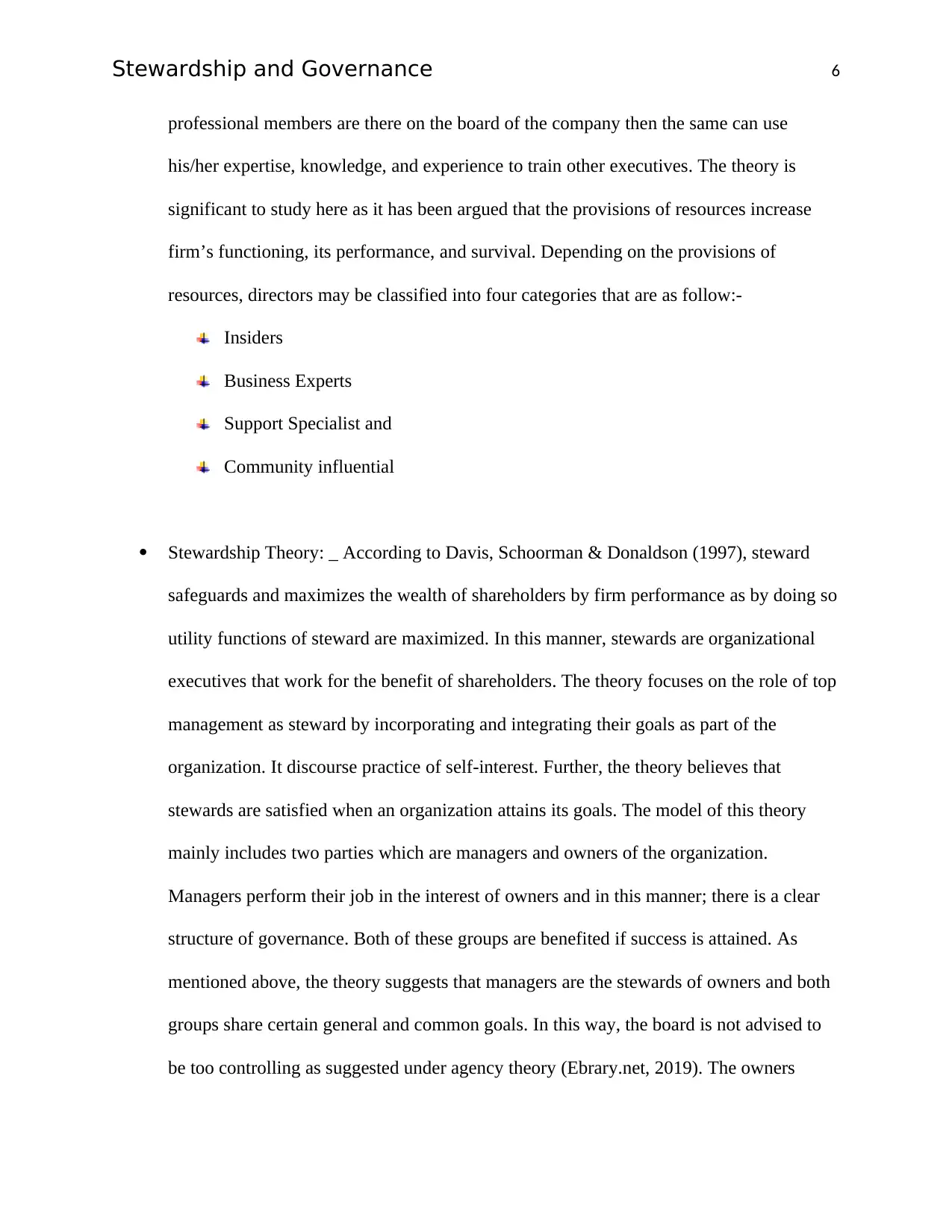
Stewardship and Governance 6
professional members are there on the board of the company then the same can use
his/her expertise, knowledge, and experience to train other executives. The theory is
significant to study here as it has been argued that the provisions of resources increase
firm’s functioning, its performance, and survival. Depending on the provisions of
resources, directors may be classified into four categories that are as follow:-
Insiders
Business Experts
Support Specialist and
Community influential
Stewardship Theory: _ According to Davis, Schoorman & Donaldson (1997), steward
safeguards and maximizes the wealth of shareholders by firm performance as by doing so
utility functions of steward are maximized. In this manner, stewards are organizational
executives that work for the benefit of shareholders. The theory focuses on the role of top
management as steward by incorporating and integrating their goals as part of the
organization. It discourse practice of self-interest. Further, the theory believes that
stewards are satisfied when an organization attains its goals. The model of this theory
mainly includes two parties which are managers and owners of the organization.
Managers perform their job in the interest of owners and in this manner; there is a clear
structure of governance. Both of these groups are benefited if success is attained. As
mentioned above, the theory suggests that managers are the stewards of owners and both
groups share certain general and common goals. In this way, the board is not advised to
be too controlling as suggested under agency theory (Ebrary.net, 2019). The owners
professional members are there on the board of the company then the same can use
his/her expertise, knowledge, and experience to train other executives. The theory is
significant to study here as it has been argued that the provisions of resources increase
firm’s functioning, its performance, and survival. Depending on the provisions of
resources, directors may be classified into four categories that are as follow:-
Insiders
Business Experts
Support Specialist and
Community influential
Stewardship Theory: _ According to Davis, Schoorman & Donaldson (1997), steward
safeguards and maximizes the wealth of shareholders by firm performance as by doing so
utility functions of steward are maximized. In this manner, stewards are organizational
executives that work for the benefit of shareholders. The theory focuses on the role of top
management as steward by incorporating and integrating their goals as part of the
organization. It discourse practice of self-interest. Further, the theory believes that
stewards are satisfied when an organization attains its goals. The model of this theory
mainly includes two parties which are managers and owners of the organization.
Managers perform their job in the interest of owners and in this manner; there is a clear
structure of governance. Both of these groups are benefited if success is attained. As
mentioned above, the theory suggests that managers are the stewards of owners and both
groups share certain general and common goals. In this way, the board is not advised to
be too controlling as suggested under agency theory (Ebrary.net, 2019). The owners
Paraphrase This Document
Need a fresh take? Get an instant paraphrase of this document with our AI Paraphraser
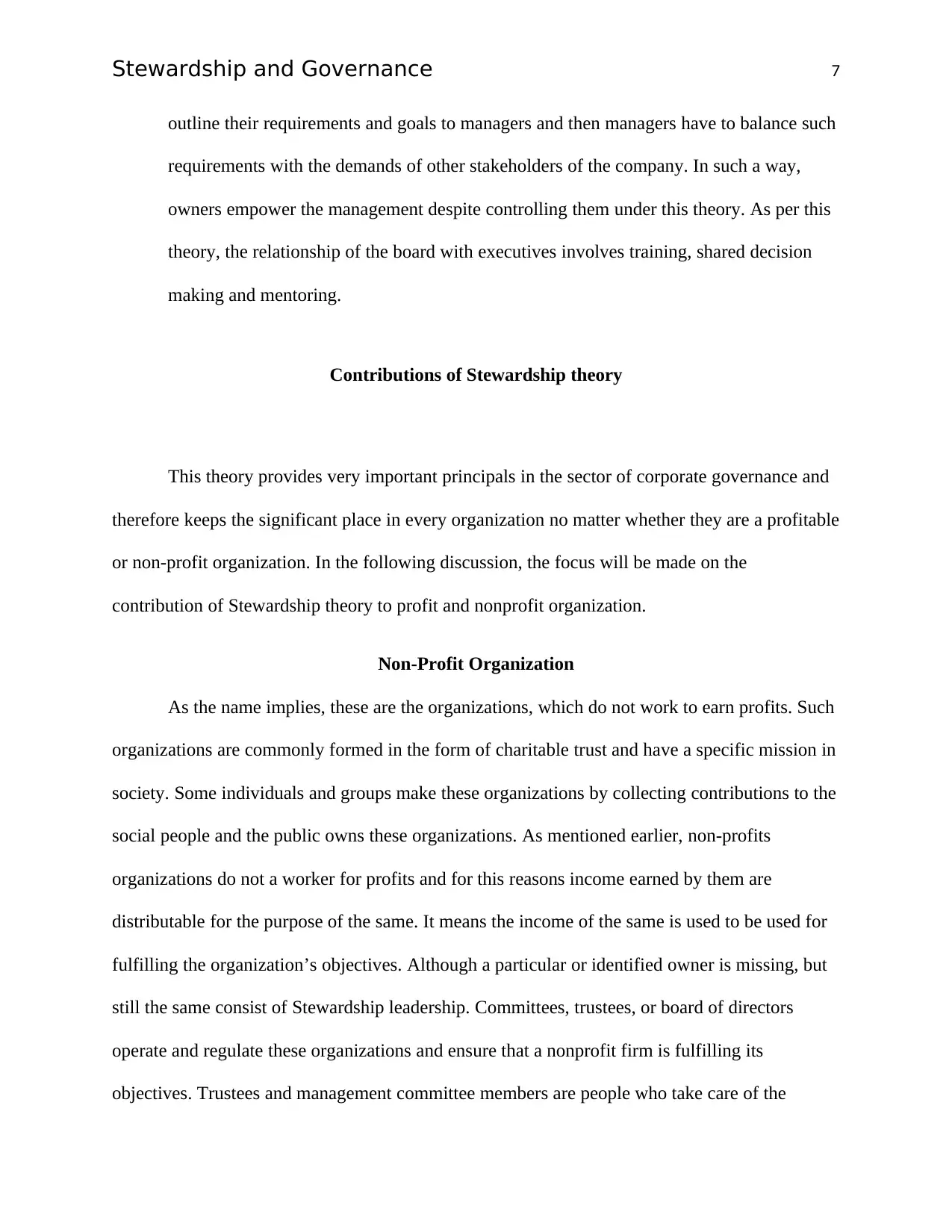
Stewardship and Governance 7
outline their requirements and goals to managers and then managers have to balance such
requirements with the demands of other stakeholders of the company. In such a way,
owners empower the management despite controlling them under this theory. As per this
theory, the relationship of the board with executives involves training, shared decision
making and mentoring.
Contributions of Stewardship theory
This theory provides very important principals in the sector of corporate governance and
therefore keeps the significant place in every organization no matter whether they are a profitable
or non-profit organization. In the following discussion, the focus will be made on the
contribution of Stewardship theory to profit and nonprofit organization.
Non-Profit Organization
As the name implies, these are the organizations, which do not work to earn profits. Such
organizations are commonly formed in the form of charitable trust and have a specific mission in
society. Some individuals and groups make these organizations by collecting contributions to the
social people and the public owns these organizations. As mentioned earlier, non-profits
organizations do not a worker for profits and for this reasons income earned by them are
distributable for the purpose of the same. It means the income of the same is used to be used for
fulfilling the organization’s objectives. Although a particular or identified owner is missing, but
still the same consist of Stewardship leadership. Committees, trustees, or board of directors
operate and regulate these organizations and ensure that a nonprofit firm is fulfilling its
objectives. Trustees and management committee members are people who take care of the
outline their requirements and goals to managers and then managers have to balance such
requirements with the demands of other stakeholders of the company. In such a way,
owners empower the management despite controlling them under this theory. As per this
theory, the relationship of the board with executives involves training, shared decision
making and mentoring.
Contributions of Stewardship theory
This theory provides very important principals in the sector of corporate governance and
therefore keeps the significant place in every organization no matter whether they are a profitable
or non-profit organization. In the following discussion, the focus will be made on the
contribution of Stewardship theory to profit and nonprofit organization.
Non-Profit Organization
As the name implies, these are the organizations, which do not work to earn profits. Such
organizations are commonly formed in the form of charitable trust and have a specific mission in
society. Some individuals and groups make these organizations by collecting contributions to the
social people and the public owns these organizations. As mentioned earlier, non-profits
organizations do not a worker for profits and for this reasons income earned by them are
distributable for the purpose of the same. It means the income of the same is used to be used for
fulfilling the organization’s objectives. Although a particular or identified owner is missing, but
still the same consist of Stewardship leadership. Committees, trustees, or board of directors
operate and regulate these organizations and ensure that a nonprofit firm is fulfilling its
objectives. Trustees and management committee members are people who take care of the
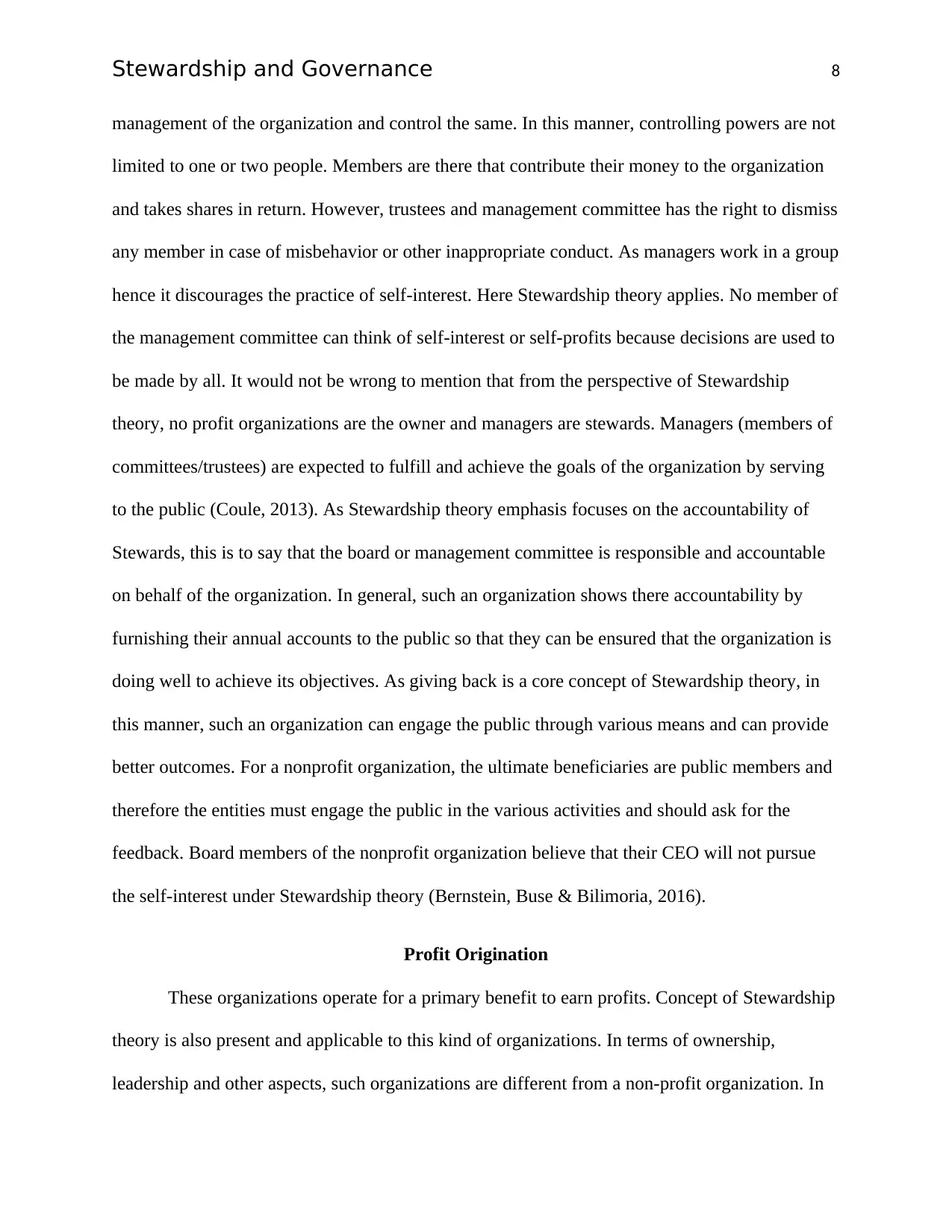
Stewardship and Governance 8
management of the organization and control the same. In this manner, controlling powers are not
limited to one or two people. Members are there that contribute their money to the organization
and takes shares in return. However, trustees and management committee has the right to dismiss
any member in case of misbehavior or other inappropriate conduct. As managers work in a group
hence it discourages the practice of self-interest. Here Stewardship theory applies. No member of
the management committee can think of self-interest or self-profits because decisions are used to
be made by all. It would not be wrong to mention that from the perspective of Stewardship
theory, no profit organizations are the owner and managers are stewards. Managers (members of
committees/trustees) are expected to fulfill and achieve the goals of the organization by serving
to the public (Coule, 2013). As Stewardship theory emphasis focuses on the accountability of
Stewards, this is to say that the board or management committee is responsible and accountable
on behalf of the organization. In general, such an organization shows there accountability by
furnishing their annual accounts to the public so that they can be ensured that the organization is
doing well to achieve its objectives. As giving back is a core concept of Stewardship theory, in
this manner, such an organization can engage the public through various means and can provide
better outcomes. For a nonprofit organization, the ultimate beneficiaries are public members and
therefore the entities must engage the public in the various activities and should ask for the
feedback. Board members of the nonprofit organization believe that their CEO will not pursue
the self-interest under Stewardship theory (Bernstein, Buse & Bilimoria, 2016).
Profit Origination
These organizations operate for a primary benefit to earn profits. Concept of Stewardship
theory is also present and applicable to this kind of organizations. In terms of ownership,
leadership and other aspects, such organizations are different from a non-profit organization. In
management of the organization and control the same. In this manner, controlling powers are not
limited to one or two people. Members are there that contribute their money to the organization
and takes shares in return. However, trustees and management committee has the right to dismiss
any member in case of misbehavior or other inappropriate conduct. As managers work in a group
hence it discourages the practice of self-interest. Here Stewardship theory applies. No member of
the management committee can think of self-interest or self-profits because decisions are used to
be made by all. It would not be wrong to mention that from the perspective of Stewardship
theory, no profit organizations are the owner and managers are stewards. Managers (members of
committees/trustees) are expected to fulfill and achieve the goals of the organization by serving
to the public (Coule, 2013). As Stewardship theory emphasis focuses on the accountability of
Stewards, this is to say that the board or management committee is responsible and accountable
on behalf of the organization. In general, such an organization shows there accountability by
furnishing their annual accounts to the public so that they can be ensured that the organization is
doing well to achieve its objectives. As giving back is a core concept of Stewardship theory, in
this manner, such an organization can engage the public through various means and can provide
better outcomes. For a nonprofit organization, the ultimate beneficiaries are public members and
therefore the entities must engage the public in the various activities and should ask for the
feedback. Board members of the nonprofit organization believe that their CEO will not pursue
the self-interest under Stewardship theory (Bernstein, Buse & Bilimoria, 2016).
Profit Origination
These organizations operate for a primary benefit to earn profits. Concept of Stewardship
theory is also present and applicable to this kind of organizations. In terms of ownership,
leadership and other aspects, such organizations are different from a non-profit organization. In
⊘ This is a preview!⊘
Do you want full access?
Subscribe today to unlock all pages.

Trusted by 1+ million students worldwide
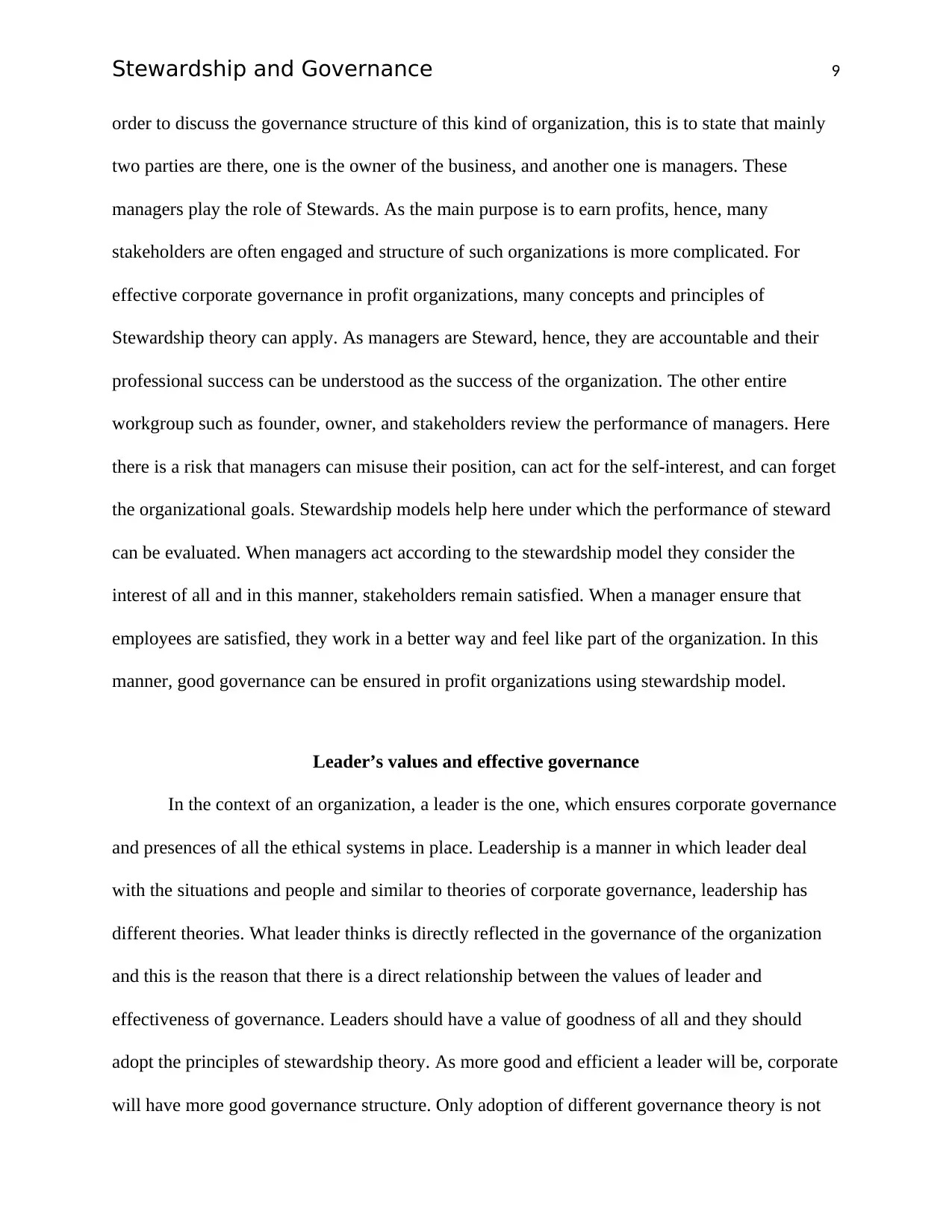
Stewardship and Governance 9
order to discuss the governance structure of this kind of organization, this is to state that mainly
two parties are there, one is the owner of the business, and another one is managers. These
managers play the role of Stewards. As the main purpose is to earn profits, hence, many
stakeholders are often engaged and structure of such organizations is more complicated. For
effective corporate governance in profit organizations, many concepts and principles of
Stewardship theory can apply. As managers are Steward, hence, they are accountable and their
professional success can be understood as the success of the organization. The other entire
workgroup such as founder, owner, and stakeholders review the performance of managers. Here
there is a risk that managers can misuse their position, can act for the self-interest, and can forget
the organizational goals. Stewardship models help here under which the performance of steward
can be evaluated. When managers act according to the stewardship model they consider the
interest of all and in this manner, stakeholders remain satisfied. When a manager ensure that
employees are satisfied, they work in a better way and feel like part of the organization. In this
manner, good governance can be ensured in profit organizations using stewardship model.
Leader’s values and effective governance
In the context of an organization, a leader is the one, which ensures corporate governance
and presences of all the ethical systems in place. Leadership is a manner in which leader deal
with the situations and people and similar to theories of corporate governance, leadership has
different theories. What leader thinks is directly reflected in the governance of the organization
and this is the reason that there is a direct relationship between the values of leader and
effectiveness of governance. Leaders should have a value of goodness of all and they should
adopt the principles of stewardship theory. As more good and efficient a leader will be, corporate
will have more good governance structure. Only adoption of different governance theory is not
order to discuss the governance structure of this kind of organization, this is to state that mainly
two parties are there, one is the owner of the business, and another one is managers. These
managers play the role of Stewards. As the main purpose is to earn profits, hence, many
stakeholders are often engaged and structure of such organizations is more complicated. For
effective corporate governance in profit organizations, many concepts and principles of
Stewardship theory can apply. As managers are Steward, hence, they are accountable and their
professional success can be understood as the success of the organization. The other entire
workgroup such as founder, owner, and stakeholders review the performance of managers. Here
there is a risk that managers can misuse their position, can act for the self-interest, and can forget
the organizational goals. Stewardship models help here under which the performance of steward
can be evaluated. When managers act according to the stewardship model they consider the
interest of all and in this manner, stakeholders remain satisfied. When a manager ensure that
employees are satisfied, they work in a better way and feel like part of the organization. In this
manner, good governance can be ensured in profit organizations using stewardship model.
Leader’s values and effective governance
In the context of an organization, a leader is the one, which ensures corporate governance
and presences of all the ethical systems in place. Leadership is a manner in which leader deal
with the situations and people and similar to theories of corporate governance, leadership has
different theories. What leader thinks is directly reflected in the governance of the organization
and this is the reason that there is a direct relationship between the values of leader and
effectiveness of governance. Leaders should have a value of goodness of all and they should
adopt the principles of stewardship theory. As more good and efficient a leader will be, corporate
will have more good governance structure. Only adoption of different governance theory is not
Paraphrase This Document
Need a fresh take? Get an instant paraphrase of this document with our AI Paraphraser
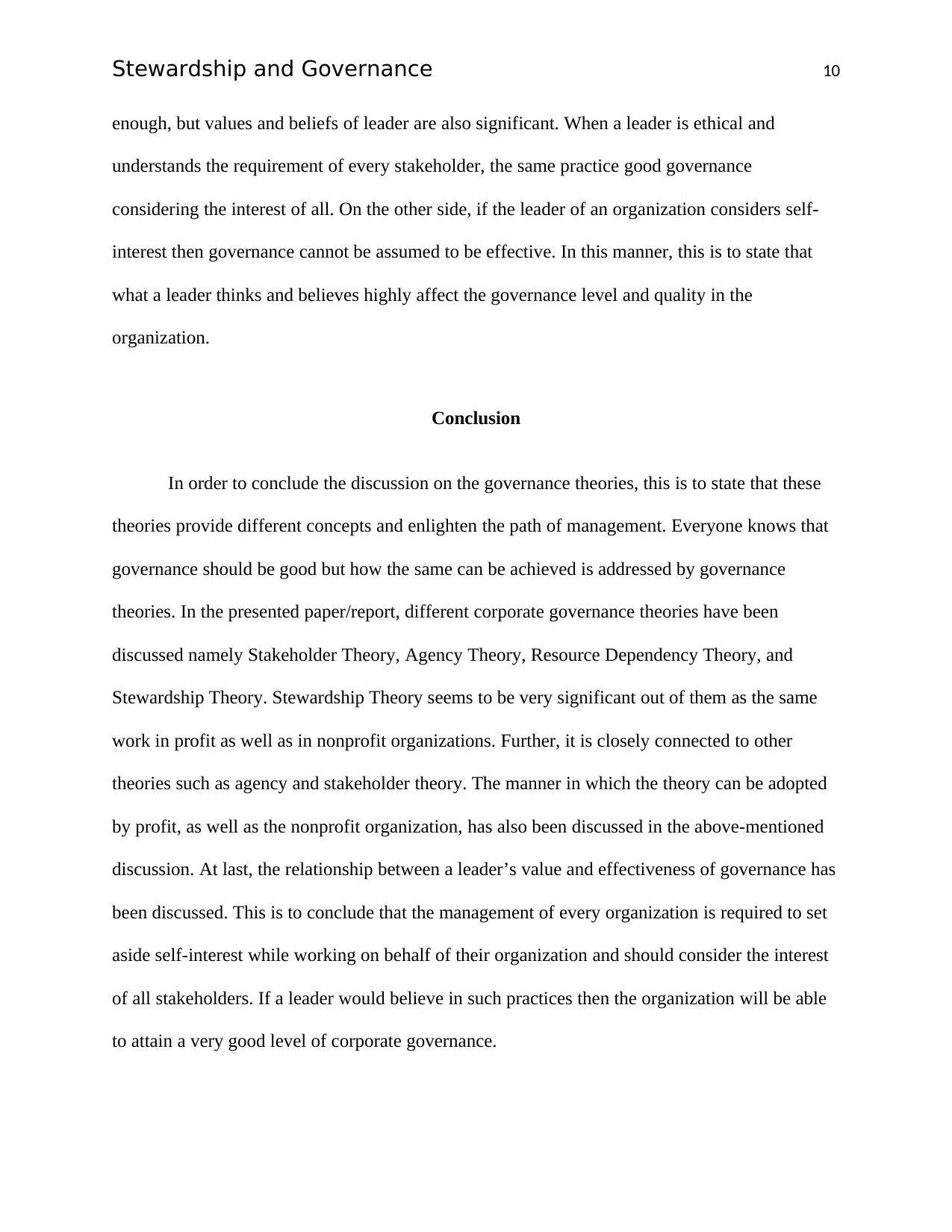
Stewardship and Governance 10
enough, but values and beliefs of leader are also significant. When a leader is ethical and
understands the requirement of every stakeholder, the same practice good governance
considering the interest of all. On the other side, if the leader of an organization considers self-
interest then governance cannot be assumed to be effective. In this manner, this is to state that
what a leader thinks and believes highly affect the governance level and quality in the
organization.
Conclusion
In order to conclude the discussion on the governance theories, this is to state that these
theories provide different concepts and enlighten the path of management. Everyone knows that
governance should be good but how the same can be achieved is addressed by governance
theories. In the presented paper/report, different corporate governance theories have been
discussed namely Stakeholder Theory, Agency Theory, Resource Dependency Theory, and
Stewardship Theory. Stewardship Theory seems to be very significant out of them as the same
work in profit as well as in nonprofit organizations. Further, it is closely connected to other
theories such as agency and stakeholder theory. The manner in which the theory can be adopted
by profit, as well as the nonprofit organization, has also been discussed in the above-mentioned
discussion. At last, the relationship between a leader’s value and effectiveness of governance has
been discussed. This is to conclude that the management of every organization is required to set
aside self-interest while working on behalf of their organization and should consider the interest
of all stakeholders. If a leader would believe in such practices then the organization will be able
to attain a very good level of corporate governance.
enough, but values and beliefs of leader are also significant. When a leader is ethical and
understands the requirement of every stakeholder, the same practice good governance
considering the interest of all. On the other side, if the leader of an organization considers self-
interest then governance cannot be assumed to be effective. In this manner, this is to state that
what a leader thinks and believes highly affect the governance level and quality in the
organization.
Conclusion
In order to conclude the discussion on the governance theories, this is to state that these
theories provide different concepts and enlighten the path of management. Everyone knows that
governance should be good but how the same can be achieved is addressed by governance
theories. In the presented paper/report, different corporate governance theories have been
discussed namely Stakeholder Theory, Agency Theory, Resource Dependency Theory, and
Stewardship Theory. Stewardship Theory seems to be very significant out of them as the same
work in profit as well as in nonprofit organizations. Further, it is closely connected to other
theories such as agency and stakeholder theory. The manner in which the theory can be adopted
by profit, as well as the nonprofit organization, has also been discussed in the above-mentioned
discussion. At last, the relationship between a leader’s value and effectiveness of governance has
been discussed. This is to conclude that the management of every organization is required to set
aside self-interest while working on behalf of their organization and should consider the interest
of all stakeholders. If a leader would believe in such practices then the organization will be able
to attain a very good level of corporate governance.
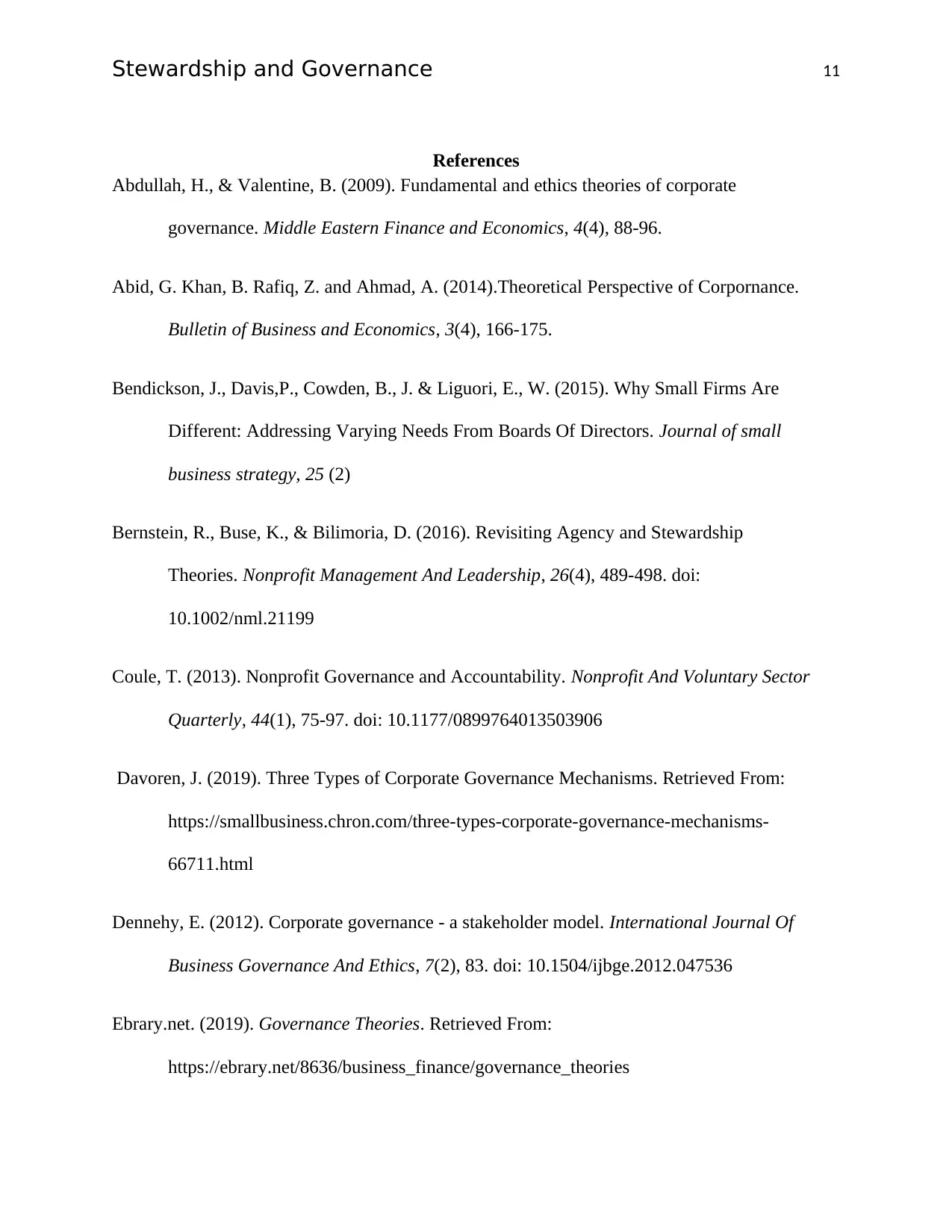
Stewardship and Governance 11
References
Abdullah, H., & Valentine, B. (2009). Fundamental and ethics theories of corporate
governance. Middle Eastern Finance and Economics, 4(4), 88-96.
Abid, G. Khan, B. Rafiq, Z. and Ahmad, A. (2014).Theoretical Perspective of Corpornance.
Bulletin of Business and Economics, 3(4), 166-175.
Bendickson, J., Davis,P., Cowden, B., J. & Liguori, E., W. (2015). Why Small Firms Are
Different: Addressing Varying Needs From Boards Of Directors. Journal of small
business strategy, 25 (2)
Bernstein, R., Buse, K., & Bilimoria, D. (2016). Revisiting Agency and Stewardship
Theories. Nonprofit Management And Leadership, 26(4), 489-498. doi:
10.1002/nml.21199
Coule, T. (2013). Nonprofit Governance and Accountability. Nonprofit And Voluntary Sector
Quarterly, 44(1), 75-97. doi: 10.1177/0899764013503906
Davoren, J. (2019). Three Types of Corporate Governance Mechanisms. Retrieved From:
https://smallbusiness.chron.com/three-types-corporate-governance-mechanisms-
66711.html
Dennehy, E. (2012). Corporate governance - a stakeholder model. International Journal Of
Business Governance And Ethics, 7(2), 83. doi: 10.1504/ijbge.2012.047536
Ebrary.net. (2019). Governance Theories. Retrieved From:
https://ebrary.net/8636/business_finance/governance_theories
References
Abdullah, H., & Valentine, B. (2009). Fundamental and ethics theories of corporate
governance. Middle Eastern Finance and Economics, 4(4), 88-96.
Abid, G. Khan, B. Rafiq, Z. and Ahmad, A. (2014).Theoretical Perspective of Corpornance.
Bulletin of Business and Economics, 3(4), 166-175.
Bendickson, J., Davis,P., Cowden, B., J. & Liguori, E., W. (2015). Why Small Firms Are
Different: Addressing Varying Needs From Boards Of Directors. Journal of small
business strategy, 25 (2)
Bernstein, R., Buse, K., & Bilimoria, D. (2016). Revisiting Agency and Stewardship
Theories. Nonprofit Management And Leadership, 26(4), 489-498. doi:
10.1002/nml.21199
Coule, T. (2013). Nonprofit Governance and Accountability. Nonprofit And Voluntary Sector
Quarterly, 44(1), 75-97. doi: 10.1177/0899764013503906
Davoren, J. (2019). Three Types of Corporate Governance Mechanisms. Retrieved From:
https://smallbusiness.chron.com/three-types-corporate-governance-mechanisms-
66711.html
Dennehy, E. (2012). Corporate governance - a stakeholder model. International Journal Of
Business Governance And Ethics, 7(2), 83. doi: 10.1504/ijbge.2012.047536
Ebrary.net. (2019). Governance Theories. Retrieved From:
https://ebrary.net/8636/business_finance/governance_theories
⊘ This is a preview!⊘
Do you want full access?
Subscribe today to unlock all pages.

Trusted by 1+ million students worldwide
1 out of 13
Related Documents
Your All-in-One AI-Powered Toolkit for Academic Success.
+13062052269
info@desklib.com
Available 24*7 on WhatsApp / Email
![[object Object]](/_next/static/media/star-bottom.7253800d.svg)
Unlock your academic potential
Copyright © 2020–2025 A2Z Services. All Rights Reserved. Developed and managed by ZUCOL.





